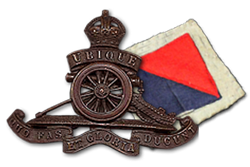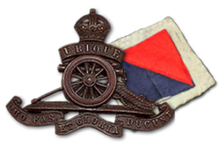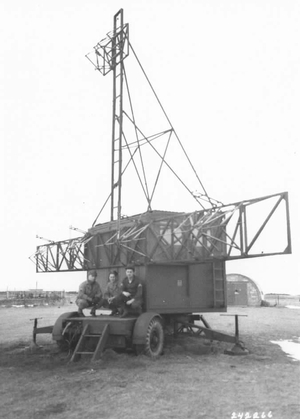27th Anti-Aircraft Brigade was an Air Defence formation of the British Army in the Second World War that served in The Blitz and later converted to infantry.
28th Anti-Aircraft Brigade was an air defence formation of the British Territorial Army created in 1925 to command anti-aircraft units in Kent and around the militarily important Medway Towns, which it defended during the Second World War. In 1940 the brigade was responsible for the defences on the south side of the Thames Estuary including the Royal Naval Dockyard at Chatham and the Port of Dover. The brigade was heavily engaged throughout the Battle of Britain, in the summer of 1940, and The Blitz, from autumn 1940 to spring 1941, operating a total of 70 heavy anti-aircraft (HAA) guns controlled from a gun operations room (GOR) at Chatham. During 1942 many of the brigade's experienced units were transferred to active theatres overseas. Increasingly the brigade included women of the Auxiliary Territorial Service (ATS).
The 31st Anti-Aircraft Brigade was an air defence formation of Britain's Territorial Army from 1936 until 1948. During the Second World War it defended West Yorkshire and later participated in the North West Europe campaign.
The 32nd (Midland) Anti-Aircraft Brigade was an air defence formation of Anti-Aircraft Command in Britain's Territorial Army (TA) from 1936 to 1955, charged with defending the East Midlands of England.
The 34th Anti-Aircraft Brigade was an air defence formation of Anti-Aircraft Command in the British Territorial Army formed shortly before the outbreak of the Second World War. It defended the West Midlands of England during The Blitz.
The 37th Anti-Aircraft Brigade was an air defence formation of Britain's Territorial Army (TA) formed just before the outbreak of World War II. It was engaged in defending the Thames Estuary during the war, and continued to form part of Anti-Aircraft Command in the postwar era.
39th Anti-Aircraft Brigade was an air defence formation of Britain's Territorial Army (TA) during the Second World War. It was responsible under Anti-Aircraft Command for protecting industry along the Humber Estuary and airfields in Lincolnshire during The Blitz. Later it defended the coast of East Anglia against Luftwaffe 'hit-and-run' attacks. It was later converted to a field force formation, covered the embarkation ports for Operation Overlord and defended London against V-1 flying bombs. It served in the campaign in North West Europe, defending Antwerp against V-1s and supervising the clean-up of the notorious Bergen-Belsen concentration camp.
42nd Anti-Aircraft Brigade was an air defence formation of Britain's Territorial Army (TA). It was responsible for protecting the City of Glasgow and industry along the Firth of Clyde during the Second World War.
The 80th Anti-Aircraft Brigade was an air defence formation of the British Army during the Second World War. It landed on D-Day and saw action throughout the campaign in North West Europe, providing early warning of attacks by V-1 flying bombs against Antwerp during the winter of 1944–45.
The 76th Anti-Aircraft Brigade was an air defence formation of the British Army during the Second World War. It landed on D-Day and saw action throughout the campaign in North West Europe. Its guns operated in both anti-aircraft (AA) and ground roles in clearing and then defending the Scheldt Estuary until the end of the war.

The 73rd Light Anti-Aircraft Regiment, was an air defence unit of the British Army's Royal Artillery during World War II. It served during the London Blitz, landed on D-Day, seeing action throughout the campaign in North West Europe and defending the cities of Belgium against V-1 flying bombs.

The 113th Heavy Anti-Aircraft Regiment was an air defence unit of the British Army's Royal Artillery during World War II. It saw action during The Blitz, landed in Normandy on D-Day and served throughout the subsequent campaign in North West Europe, operating as medium artillery in the Battle of the Scheldt, Unusually, its AA guns were successfully used to destroy enemy submarines in the closing stages of the war.
The 86th Heavy Anti-Aircraft Regiment, Royal Artillery was an air defence unit of Britain's Territorial Army (TA) that served throughout World War II. It defended London during The Blitz, landed on Juno Beach on D-Day, and defended the cities of Belgium against V-1 flying bombs.
50th Light Anti-Aircraft Brigade was an air defence formation of Britain's Territorial Army (TA) during the Second World War. It defended the North Midlands of England during The Blitz and later helped to protect Brussels from V-1 flying bombs during the Campaign in North West Europe.

The 89th Heavy Anti-Aircraft Regiment, Royal Artillery was an air defence unit of Britain's Territorial Army (TA) raised in Kent just before the outbreak of World War II. It served during the Battle of Britain and defended the Suez Canal while batteries served in the Battle of Crete and the Siege of Tobruk. The regiment then fought through the North African and Italian campaigns.

175th Heavy Anti-Aircraft Regiment, Royal Artillery was an air defence unit of the British Army formed during World War II. It served in defence of the vital naval and air base at Gibraltar.

91st Heavy Anti-Aircraft Regiment, Royal Artillery was a part-time unit of Britain's Territorial Army (TA) formed in the West Riding of Yorkshire just before the outbreak of World War II. Its service during the war included Home Defence during the Battle of Britain and The Blitz, and a length period in Middle East Forces. Postwar it continued to serve in the TA in the air defence role until 1955.
44th Anti-Aircraft Brigade was an air defence formation of Britain's Territorial Army (TA). Formed in 1938, it was responsible for protecting Manchester and later the Isle of Wight during the Second World War. It was reformed postwar under a new title, and continued until 1955.
3rd Anti-Aircraft Brigade was a Supplementary Reserve air defence formation of the British Army formed in Northern Ireland in 1938. On the outbreak of the Second World War it saw active service with the British Expeditionary Force during the Battle of France and Operation Aerial. It then returned to Northern Ireland and defended the Province for the next two years. Postwar, it was reformed in the Territorial Army and served until the disbandment of Anti-Aircraft Command in 1955.
45th Anti-Aircraft Brigade was an air defence formation of Britain's Territorial Army (TA). Formed in 1938, it was responsible for protecting South Wales during the Second World War. It was reformed in the postwar TA under a new title, and continued until 1955.






